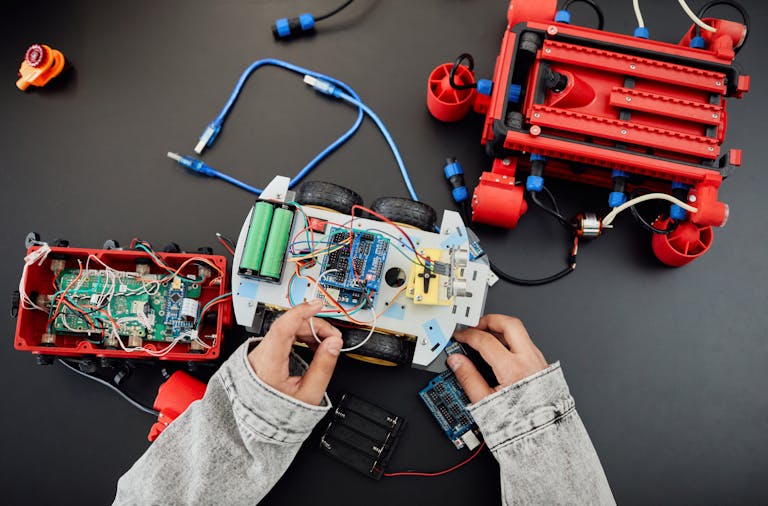Cloud sensors are essential tools for monitoring weather conditions and understanding atmospheric changes. They can be created using low-cost infrared sensors or other innovative solutions, making them accessible for hobbyists and researchers alike. With technology advancing, these sensors have become more effective and versatile, allowing for diverse applications in both personal and professional settings.
As weather monitoring becomes increasingly important, especially with changing climates, the need for reliable cloud detection grows. Low-cost cloud sensors can offer similar functionalities as their more expensive counterparts, providing valuable data on cloud cover and helping to enhance the efficiency of various systems. Individuals and organisations are finding creative ways to integrate these sensors into their projects, paving the way for smarter environmental monitoring.
Exploring the fundamentals and applications of cloud sensors reveals their impact on weather forecasting and smart technology. By understanding how these sensors operate and their integration into existing systems, users can make informed decisions on which solutions best suit their needs.
Key Takeaways
- Cloud sensors help monitor atmospheric changes effectively.
- Low-cost options are available for both hobbyists and professionals.
- Integration into smart systems enhances monitoring capabilities.
Fundamentals of Cloud Sensors

Cloud sensors play a critical role in detecting cloud cover using various principles and technologies. They utilise infrared radiation to determine the presence or absence of clouds, which is essential for meteorological observations. Understanding the role of infrared in cloud detection, as well as the function of thermopile sensors, clarifies how these devices operate.
The Role of Infrared Radiation in Cloud Detection
Infrared radiation is essential for cloud detection. Clouds emit infrared radiation, which is detectable by specific sensors. When skies are clear, the ground emits more infrared radiation than the clouds.
Cloud sensors measure the difference in these emissions. When clouds are present, they absorb and emit infrared radiation differently than the ground. This difference helps to identify cloud cover.
The ability to distinguish between clear sky and cloudy conditions significantly enhances weather forecasting accuracy. Infrared sensors are widely used in meteorological studies and remote sensing applications.
Essentials of Thermopile Sensors
Thermopile sensors are crucial components in some cloud detection systems. They convert thermal energy into electrical signals. This technique is effective for gauging infrared radiation levels from both the ground and clouds.
A thermopile consists of several thermocouples arranged to improve sensitivity. This design allows it to detect subtle changes in temperature caused by infrared radiation.
These sensors are particularly valuable for low-cost cloud detection solutions. They are relatively inexpensive compared to other sensor types, making them accessible for hobbyists and researchers alike. The simplicity and effectiveness of thermopile sensors make them a popular choice in DIY cloud sensor projects, allowing for innovative weather monitoring solutions.
Sensor Technologies and Implementations

This section explores various sensor technologies, comparing infrared (IR) sensors with low-cost alternatives. It also examines how these sensors integrate with popular platforms like Raspberry Pi and Arduino, along with the role of graphical user interfaces (GUIs) in managing sensor data effectively.
Comparing IR Sensors and Low-Cost Alternatives
IR sensors are well-known for their accuracy in temperature measurements and proximity sensing. They operate using infrared radiation, allowing them to detect movement and measure temperature without contact.
Low-cost alternatives, such as simple temperature sensors or basic motion detectors, offer affordability. While these options may lack the precision of IR sensors, they are suitable for many basic applications.
Key Differences:
- Accuracy: IR sensors provide more precise measurements.
- Cost: Low-cost sensors are budget-friendly and easy to implement.
- Application: IR sensors are preferred in advanced monitoring systems, while low-cost sensors suit simpler projects.
Integration of Sensors with Raspberry Pi and Arduino
Raspberry Pi and Arduino are popular platforms for implementing sensor technologies. They allow users to interact with various sensors, including IR sensors and low-cost alternatives.
Raspberry Pi supports complex projects with its powerful processing capabilities and can handle multiple sensors simultaneously. It is suitable for projects requiring data analysis or visual output.
Arduino, on the other hand, is ideal for straightforward applications. Its simplicity makes it accessible for beginners. Many low-cost sensors are designed specifically for easy integration with Arduino boards.
Common Connections:
- Use GPIO pins for direct sensor connections.
- Connect via I2C or SPI protocols for enhanced functionality.
Importance of GUI in Sensor Management
Graphical user interfaces (GUIs) play a crucial role in managing sensor data. A well-designed GUI helps users monitor readings with ease and efficiency.
By visualising data, GUIs make it easier to track performance and identify trends. Users can also adjust parameters quickly.
Key Features of Effective GUIs:
- Real-time Data Display: Shows live readings from sensors.
- User Controls: Allows for calibration and settings adjustments.
- Notifications: Alerts users to abnormal readings or system errors.
Incorporating a solid GUI into sensor projects significantly enhances usability and functionality, making it an essential part of sensor management.
Applications in Weather Monitoring

Cloud sensors play a crucial role in various applications related to weather monitoring. They help assess sky conditions, detect precipitation, and provide insights into humidity and temperature levels. Understanding these applications can enhance the effectiveness of personal weather stations and advanced agricultural practices.
Cloud Sensors in Personal Weather Stations
Cloud sensors are integral to personal weather stations. They measure cloud cover and help determine sky conditions effectively. These devices, often using infrared (IR) technology, detect the infrared radiation emitted by clouds.
This information provides users with real-time data about their local weather. By knowing the cloud cover percentage, individuals can forecast upcoming changes. For example, if a high cloud cover percentage is detected, it may indicate impending rain.
Low-cost options, such as the MLX90614 IR sensor, make it accessible for hobbyists. With these sensors, personal weather stations can offer valuable insights without needing extensive expertise or high investment.
Advancements in Sky Condition Assessment
Recent advancements in cloud sensor technology have significantly improved sky condition assessments. Modern sensors can now provide precise readings of cloud thickness and height. This data is crucial for predicting weather patterns.
Developments in IoT integration allow these sensors to communicate data in real time. This real-time capability enables quicker responses to changing weather conditions. Users can receive alerts on severe weather events, such as storms, based on cloud development.
Additionally, enhanced accuracy helps farmers in making better decisions about irrigation and planting. Fast and reliable data on sky temperature and cloud cover can lead to increased crop yields.
Detecting Precipitation and Dew
Cloud sensors also excel in detecting precipitation and dew formation. By analysing temperature differences in the atmosphere, these sensors provide insights into whether moisture will fall as rain or snow.
For example, when the sensor detects a drop in temperature along with high humidity, it can signal impending dew formation. This information is vital for various fields, including agriculture and meteorology.
Moreover, by monitoring cloud cover alongside temperature data, sensors can help determine the likelihood of precipitation. Collectively, this enhances preparedness and planning for outdoor activities or agricultural tasks. Accurate detection helps in mitigating risks linked to adverse weather conditions.
Cloud Sensor Integration in Smart Systems
Integrating cloud sensors into smart systems provides enhanced capabilities for monitoring and control. This technology enables efficient presence detection and data collection, improving the functionality of smart homes and the Internet of Things.
Incorporating Cloud Sensors into Smart Homes
Cloud sensors play a vital role in creating smart homes. They allow devices to gather real-time data, such as temperature, humidity, and presence detection. Homeowners can monitor their environments remotely through mobile applications or web interfaces.
For instance, a cloud-connected motion sensor can detect movement, triggering security alerts. Smart thermostats can adjust temperatures based on occupancy, leading to energy savings. With these sensors, users can customise their home environments to suit their preferences.
- Key features of cloud sensors in smart homes:
- Real-time monitoring
- Remote access via smartphones
- Automated responses to environmental changes
The integration of cloud sensors ensures homes are safer, more energy-efficient, and more comfortable.
The Role of Cloud Sensors in the Internet of Things
In the broader context of the Internet of Things (IoT), cloud sensors are crucial for communication between devices. They facilitate data exchange, allowing various IoT devices to work together seamlessly.
These sensors gather data which is sent to the cloud for analysis. This helps in making informed decisions across systems. For example, traffic sensors can adjust signals based on real-time data, improving traffic flow.
- Benefits of cloud sensors in IoT:
- Enhanced interoperability between devices
- Ability to process large amounts of data
- Improved predictive maintenance through data analytics
Thus, cloud sensors are essential in advancing the capabilities of IoT, promoting smarter and more efficient systems.
Frequently Asked Questions
This section addresses common inquiries about cloud sensors, focusing on DIY options, specific sensor capabilities, and setup instructions for various platforms. Each question elaborates on practical considerations and technical details for effective cloud detection.
How can one build a do-it-yourself cloud detector using cost-effective components?
Building a DIY cloud detector is feasible with basic components like a simple infrared sensor and an Arduino or Raspberry Pi. Using the MLX90614 sensor is a popular choice, as it measures temperature differences between the ground and the sky. Such a simple setup can effectively indicate cloud cover by recording these temperature shifts.
What are the capabilities and limitations of the MLX90614 sensor for cloud detection?
The MLX90614 sensor measures infrared radiation to determine temperature. It can effectively detect differences in temperature between cloudy and clear skies. However, it may be affected by environmental conditions, such as surface temperatures or weather changes, which can lead to inconsistent readings under specific circumstances.
What steps are involved in setting up a Raspberry Pi for cloud sensing applications?
To use a Raspberry Pi for cloud sensing, one must first install the necessary software and libraries. After connecting the sensor to the GPIO pins, the user should write a simple script to read data from the sensor. Regular calibration and adjustment may be needed to ensure accurate cloud detection.
Can an Arduino be effectively used to create a reliable cloud detection system?
Yes, an Arduino can be used to create a reliable cloud detection system. By connecting an infrared sensor like the MLX90614 and programming the Arduino to process the data, users can monitor cloud cover effectively. The setup remains simple and cost-effective, making it popular for hobbyist projects.
Which is more suited for cloud detection: infrared sensors or ultrasonic sensors?
Infrared sensors are generally more suited for cloud detection. They measure temperature variations and can detect changes in infrared radiation caused by clouds. Ultrasonic sensors, on the other hand, are better suited for measuring distance or detecting objects, which limits their effectiveness in cloud detection applications.
How does a cloud sensor work and what are its primary functions?
A cloud sensor typically works by measuring infrared radiation emitted from objects. It determines if the sky is clear or cloudy based on temperature differences. The primary functions include providing real-time data on cloud cover, assisting in weather monitoring, and supporting research in atmospheric conditions.
As an Amazon Associate, I earn from qualifying purchases.






